The Religious Faiths
7 February 2004
The Citadel
It is odd to be in a country where Friday is the holy day and Sunday is a
workday. Schools are open on Monday through Thursday, closed for the holy
day on Friday, open on Saturday, and then closed for the Christian Sunday.
We are told the best job around is for a foreign service agent from a
Christian country because they get a three day weekend every week.
Muhammad Ali is an Egyptian hero and is considered to be the father of
modern Egypt.
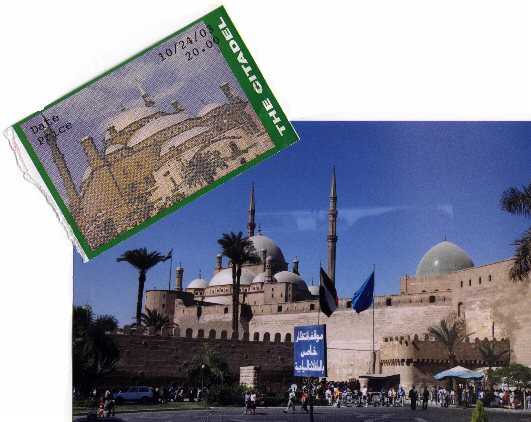 (photo 0175s)
The location of the Citadel was first occupied in 810 and has been a
fortification since that time. At one time it was fortified to protect it
against attack by the Crusaders - who never go there. The Mameluke
sultans - in charge when Napoleon invaded Egypt - made their headquarters
there. It became the seat of government of Mohammed Ali who modified the
walls and constructed numerous buildings to include the mosque named after
him. Today it is a national landmark and the object of scores of outings
for the school children who love to have their pictures taken.
(photo 0175s)
The location of the Citadel was first occupied in 810 and has been a
fortification since that time. At one time it was fortified to protect it
against attack by the Crusaders - who never go there. The Mameluke
sultans - in charge when Napoleon invaded Egypt - made their headquarters
there. It became the seat of government of Mohammed Ali who modified the
walls and constructed numerous buildings to include the mosque named after
him. Today it is a national landmark and the object of scores of outings
for the school children who love to have their pictures taken.
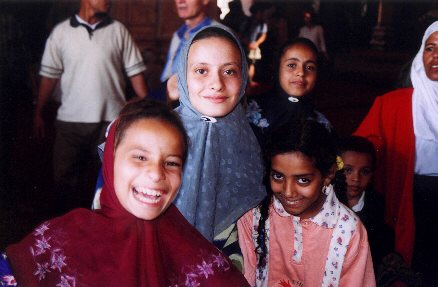 (photo 0173s)
In the courtyard is a beautiful alabaster fountain used for washing hands
and feet before entering the mosque and behind it is a clock, a gift from
Louis-Philippe of France to Mohammed Ali in return for an ancient obelisk he
allowed the French to take home. The clock, like the French government, has
never worked.
(photo 0173s)
In the courtyard is a beautiful alabaster fountain used for washing hands
and feet before entering the mosque and behind it is a clock, a gift from
Louis-Philippe of France to Mohammed Ali in return for an ancient obelisk he
allowed the French to take home. The clock, like the French government, has
never worked.
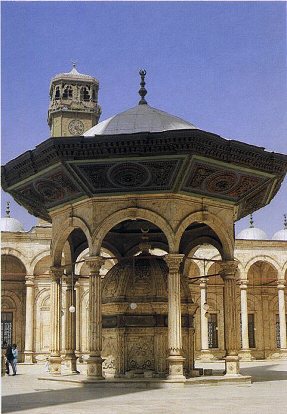 (photo 0176s)
So much for my political commentary for today.
Mohammed Ali Mosque - the Alabaster Mosque
The mosque is dominated by two slender minarets and includes a large arcaded
courtyard and vast prayer hall roofed by a 170 foot high dome. The mosque
built from 1830-57 dominates the city. It designed and built by a Greek who
tried to copy the St. Sofia mosque in Istanbul. It isn't as big but
overwhelming just the same.
(photo 0176s)
So much for my political commentary for today.
Mohammed Ali Mosque - the Alabaster Mosque
The mosque is dominated by two slender minarets and includes a large arcaded
courtyard and vast prayer hall roofed by a 170 foot high dome. The mosque
built from 1830-57 dominates the city. It designed and built by a Greek who
tried to copy the St. Sofia mosque in Istanbul. It isn't as big but
overwhelming just the same.
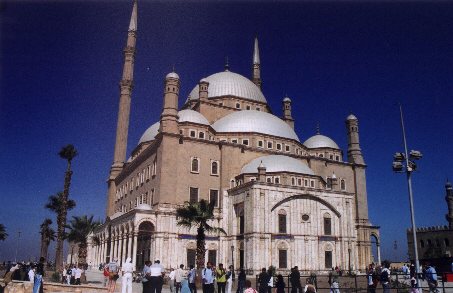 (photo 0166s)
We visited the mosque on early Friday morning before prayers and were able
to experience first hand size of the religious commitment exhibited by the
workmen in this lovely building. We removed our shoes and sat on hand
woven carpets and we listen to Maged tell us about Islam.
(photo 0166s)
We visited the mosque on early Friday morning before prayers and were able
to experience first hand size of the religious commitment exhibited by the
workmen in this lovely building. We removed our shoes and sat on hand
woven carpets and we listen to Maged tell us about Islam.
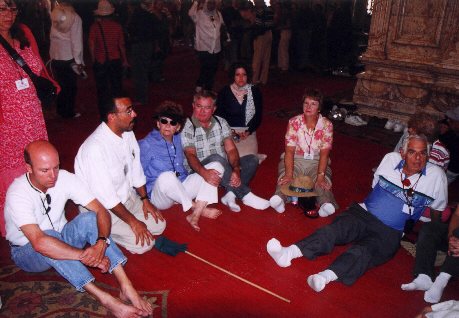 (photo 0171s)
Each group listened intently as they were told about the construction of the
building and the religious service.
(photo 0171s)
Each group listened intently as they were told about the construction of the
building and the religious service.
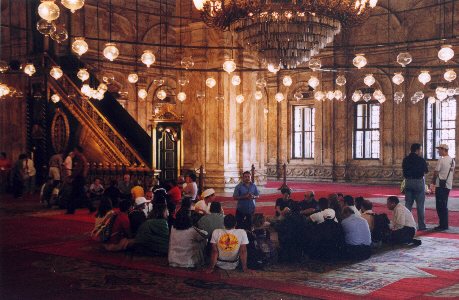 (photo 0170s)
We were told that by Islamic tradition people are not buried in a mosque as
is often the custom in Christian churches. But Egypt is different, we are
told, and Mohammed Ali is buried in one corner of this mosque. The school
children were all respectfully taken to the corner where Mohammed Ali's tomb
lies.
I tried my creative hand by taking the following picture. I thought it
would be so symbolic with the rug, my and Fran's shoes lined up, and the
hand carved alabaster column. But there is something that just doesn't look
right.
(photo 0170s)
We were told that by Islamic tradition people are not buried in a mosque as
is often the custom in Christian churches. But Egypt is different, we are
told, and Mohammed Ali is buried in one corner of this mosque. The school
children were all respectfully taken to the corner where Mohammed Ali's tomb
lies.
I tried my creative hand by taking the following picture. I thought it
would be so symbolic with the rug, my and Fran's shoes lined up, and the
hand carved alabaster column. But there is something that just doesn't look
right.
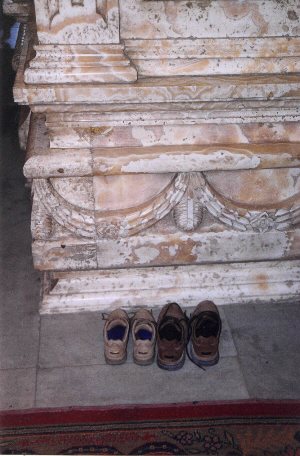 (photo 0172s)
Can you tell what it is? I try, but an artist I am not.
Friday Prayer service
After visiting the Mohammed Ali Mosque we then went to the Khan el-Khali
bazaar. At the entrance to the bazaar is a mosque - in fact they are
everywhere and it is enjoyable to listen to the call to prayer over
loudspeakers placed high on the minarets.
(photo 0172s)
Can you tell what it is? I try, but an artist I am not.
Friday Prayer service
After visiting the Mohammed Ali Mosque we then went to the Khan el-Khali
bazaar. At the entrance to the bazaar is a mosque - in fact they are
everywhere and it is enjoyable to listen to the call to prayer over
loudspeakers placed high on the minarets.
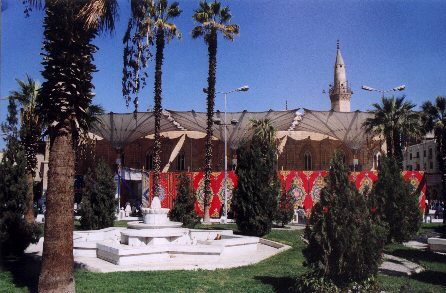 (photo 0167s)
Not all mosques may be as grand but however humble they serve the same
purpose. Dull in color they are not. Here red carpets provide privacy and
netting provides shade for those who did not come early enough to be able to
get into the building.
(photo 0168s)
Women do not worship with the men. Some may think of this as segregation
but think about it for a minute -- when Muslims pray they get down on their
hands and knees and prostrate themselves to God. It may be difficult to
keep your mind on your worship if a woman is prostrating herself in front of
you. Is this a good reason? Is it a valid reason? I don't know but it is
their culture and tradition and works for them. I understand even in the
United States that separation of women in children from the men in Jewish
Synagogues in not unusual.
(photo 0167s)
Not all mosques may be as grand but however humble they serve the same
purpose. Dull in color they are not. Here red carpets provide privacy and
netting provides shade for those who did not come early enough to be able to
get into the building.
(photo 0168s)
Women do not worship with the men. Some may think of this as segregation
but think about it for a minute -- when Muslims pray they get down on their
hands and knees and prostrate themselves to God. It may be difficult to
keep your mind on your worship if a woman is prostrating herself in front of
you. Is this a good reason? Is it a valid reason? I don't know but it is
their culture and tradition and works for them. I understand even in the
United States that separation of women in children from the men in Jewish
Synagogues in not unusual.
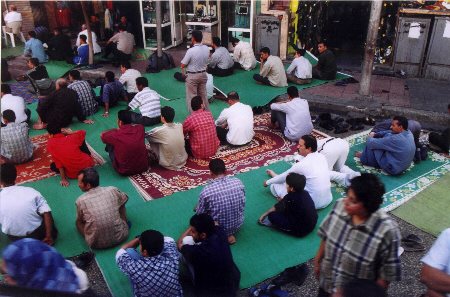 (photo 0174s)
As we rode our bus through the city we frequently saw streets in front of
mosques closed off and filled with prayer rugs because there was no room
inside. I know some ministers who would love to have that problem.
More than once we were reminded that "Islam has been hijacked by Osama Bin
Ladin" and he does not represent the faith as revealed and taught by
Mohammed the Prophet. From what I saw in Egypt and Jordan this certainly
seemed to be the case.
Time for a Smoke
Of course, after prayers its a great time to get together with friends and relax and have a pipe.
(photo 0174s)
As we rode our bus through the city we frequently saw streets in front of
mosques closed off and filled with prayer rugs because there was no room
inside. I know some ministers who would love to have that problem.
More than once we were reminded that "Islam has been hijacked by Osama Bin
Ladin" and he does not represent the faith as revealed and taught by
Mohammed the Prophet. From what I saw in Egypt and Jordan this certainly
seemed to be the case.
Time for a Smoke
Of course, after prayers its a great time to get together with friends and relax and have a pipe.
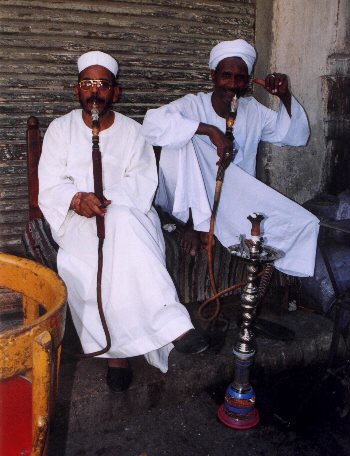 (photo 0169s)
(This page is constantly under reconstruction so come back again.)
(photo 0169s)
(This page is constantly under reconstruction so come back again.)
![]()
Jump Station
Go to The Egyption Museum of Cairo - Under Construcion
Go to The Religious Faiths - Under Construction Go to Street Scenes of Cairo - Under Construction Go to Who are the Gods? - Under Construction. Go to Chapter 9: The Khan el-Khali Bazaar - Under Construction Go to Chapter 8: The Pyramids - Under Construction Go to Chapter 7: East Thebes and the Temple of Luxor - Under Construction Return to Chapter 6: The Pyramids.Return to Chapter 5: Karnak Temple at Luxor and the Temple of Hathor at Dendera.
>Return to Chapter 4: Kom Ombo, Edfu, Karnak and Dendera.
Return to Chapter 3: Cruising Down the Nile.
Return to Chapter 2: Abu Simbel and Aswan.
Return to Chapter 1: Introduction to Egypt.
Read about my version of The Gods of Egypt and Diagram of Temples.
Return to Belli's Home Page
![]()
![]()
![]()
![]()
![]()
![]()
![]()
Test |
Testing one two three |
![]()
For more information about our travels write to![]() Belli.
Belli.
